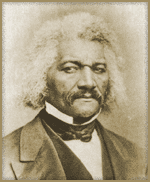







 |
 |
 |
 |
 |
| |
How could enslaved people travel on trains or ships without being discovered?
A surprising number of enslaved people escaped in trains or ships. Sometimes they borrowed or forged "free papers," legal papers that said that they were free. One reason that slaveholders did not want enslaved people to learn to read and write was that they feared that they would forge these papers. Sometimes enslaved people borrowed papers from free blacks. When Frederick Douglass escaped by riding the train from Baltimore to New York, he borrowed the freedom papers of a black sailor. He could show these to the train's conductor as proof that he had the right to be traveling northward. He later mailed these back to his friend.

Frederick Douglass escaped slavery by riding the train from Baltimore to New York using the freedom papers of a black sailor.
|
One way to smuggle enslaved people out of the south was to pack them up and ship them as freight. In the winter of 1857, a young woman in Baltimore was boxed up by her friend, taken to the train depot, and sent to Philadelphia. The young woman lacked air, water, and food. Several times the box was turned over, sending the young woman tumbling. The next day, the box arrived in Philadelphia around 10 A.M. The friend, who was free, had traveled to Philadelphia to be there when the box arrived. He hired a hackman (a man who drove a one-horse wagon) to pick up the box and deliver it to the home of Mrs. Myers, a free black woman. Mrs. Myers, who was originally from Baltimore, frequently received fugitives traveling on the Underground Railroad.
Mrs. Myers was so afraid that the young woman would be dead after the journey that she asked her neighbor, who was an undertaker, to be present when she opened the box. The young woman did survive, but she was very weak. At first, she could not speak. They finally got her out and helped her upstairs where she went to bed for the rest of the day. It was three days until she was strong enough to talk in a normal way. She had almost died in that box, but her desire for freedom was so strong that she risked it. After three or four days with the Myers family, the young woman was sent on to Canada.
Did enslaved people ever wear disguises?
« back to About home
|
|
 |
 |
 |
|
 |
|










